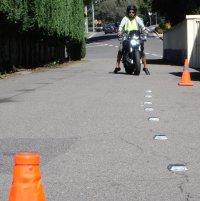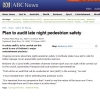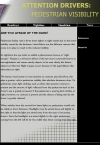Please note: we are not taking orders until February 2017.
Reasearch & development of Solar Road Markers
After assesing the dangers of night driving and experience with LEDs (Light Emitting Diodes) and electronics, we built a prototype for a simple environmentally friendly solution based on the idea to make dangeorus roads look like airport runways for easy navigation. This type of lane marking was already used in a few areas around Sydney, BUT they were all hard-wired (from underground) and mainly used for lane changing (south of Airport on General Holmes Dr and Military Road Nuetral Bay). Our challenge was to make it in an easy self contained marker that can be placed on the road, that can be installed anywhere, without electricty infrastructure, road alterations quickly and maintance free.
There were already similar products on the market, but they were expensive, not as bright and too large to be used on the road, to meet Australian standards for a common road marker. In just under half a year we came out with our Flat Stud model to meet the same safety dimensions as the current Australian reflective road markers. Brighter than the rest, tamper proof, less expensive.
Danger of Driving at Night
We are not nocturnal creatures - we can’t see in the dark like possums do. Most of us are aware that driving at night is more demanding and stressful than driving in the daytime. We make natural compensations for this as we drive but it is a fact that the number of night road road crashes is much greater than those that occur during the day. All we have to rely on are our vehicles head lights and street lighting. Adding to this danger is the phenomenon of Night Myopia.
What is night myopia?
Myopia is the refractive defect of the eye more commonly known as nearsightedess and causes nearby objects to be seen clearly but distant objects are blurred. Night myopia occurs because of the pupil dilation that takes place at night or in dark conditions.
Road lighting levels at night are obviously lower than those found by day. This causes the pupil of the eye to become larger during night driving than under brighter conditions and the increase in pupil size can accentuate any existing small errors in focusing, causing blur. This blurriness can also increase the rate of fatigue.
Night Mypoia and Pedestrians
The human visual system is most sensitive to contrast and, therefore, this plays a greater role in pedestrian and object visibility than absolute luminance does. Clothes on pedestrians is not reflective, and dark colours absorbs light, therefore making pedestrians almost invisible. And remember to picture this through a windscreen at 60km-80 km per hour.
When vehicles have the normal low beam lights on, pedestrians would only be visible at short distances. By Australian Standards, when cars are imported, headlights must be aimed down and slightly to the left so that the lights are aimed away from the eyes of oncoming drivers. Since the headlights are aimed slightly to the left, pedestrians entering from the right will be even far less visible than those coming from the left.
Unfortunately a variety of changes in the eye can contribute to discomfort from glare during night driving (from other vehicles and street lighting) particularly among older drivers. This is commonly caused by cataracts which produce effects similar to looking through a dirty window.
Solar Road Markers would benefit both elderly drivers who could see certain hazards on the road better at night and that they could cross Pedestrian Refuges with more confidence knowing that drives would pay more attention to those traffic features. Elderly Pedestrians cant walk as fast as the rest of us and they have slower reaction times.
Dark Rainy Nights in Urban Environments
Another dangerous combination is rain, wet roads, headlighs and city lights including street lights.
Have you ever travelled through the Sydney CBD on a rainy night? Do you remember saying to yourself, “I cant see the lanes, theyre invisible”
This is because the water on the road becomes a sheet of glass or mirror and reflects the white glare from street lights above, and vehicles headlights, taking away the visibility of white painted lines on the road.
Trials and Research on the roads
Once we got our first prototypes we went out and tested them amoung drivers on the roads of Sydney and in rural areas.
We came up with the conclusion, that apart from highlighting a dangerous curve. The product can be used to warn drivers at a distance on the approach to a dangerous bend or road hazard.
This is done by simply using a flashing version of the marker. Flashing lights are percieved by drivers as a warning signal.
Using Solar Road Markers at features such as Pedestrian Refuges/Crossings, or merging lanes alerts the drivers attention to that particular hazard. It does this also by keeping the drivers eyesight at that particular hazard on road level, rather than distraction by signs.
One example was a Pedestrian Refuge where we placed two flashing markers. Cars would slow down or use their brakes on approach to the refuge. They would take more notice to the feature. Once we removed the markers, we noted that most cars did not take much notice of the refuges or did not reduce speed.
Pedestrian Safety at night



